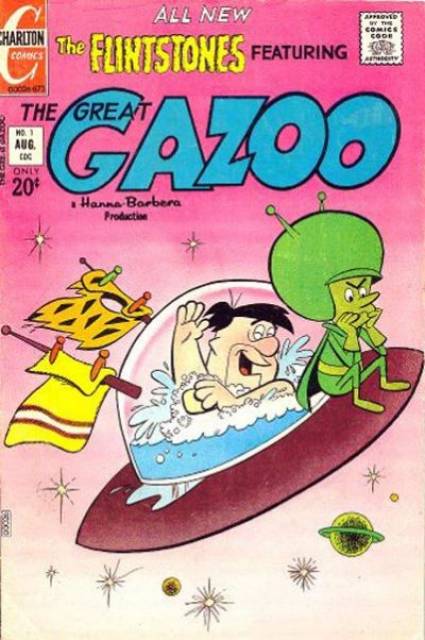
Why do we imagine aliens as 'little green men'?
How did it become so widely accepted as a reference to visitors from other worlds?
On April 21, 2016, U.S. Army Chief of Staff Gen. Mark Milley delivered a speech at a military reserve training program at Norwich University in Vermont. At the time, he likely didn't expect that his words would fuel widespread speculation on the internet about the military engaging with UFOs and extraterrestrials.
Then again, he did tell an audience of cadets, "You'll be dealing with little green men," the Army Times reported.
The general was probably using a more recent version of the phrase "little green men" that refers to military personnel in Russia and Ukraine — so-called because of the color of their uniforms, the BBC explained.
Related: Greetings, Earthlings! 8 ways aliens could contact us
But for many people, "little green men" means just one thing: extraterrestrial life. This description of alien beings — which are usually mischievous or even downright malevolent — has endured as a staple of science-fiction vocabulary for many decades, appearing in countless sci-fi stories, movies and television programs.
But where did the idea of diminutive, verdant, otherworldly invaders come from, and how did it come to be so widely accepted as a way of referring to visitors from other worlds?
It's not easy being green
The trope may actually predate science fiction itself, hearkening back to a 12th-century English legend known as "The Green Children of Woolpit," said Arthur Evans, managing editor of the journal Science Fiction Studies (SFS) at DePauw University in Indiana.
Sign up for the Live Science daily newsletter now
Get the world’s most fascinating discoveries delivered straight to your inbox.
In a 2006 study published in SFS, scientists described this folktale, which recounts the unexplained appearance of two children with green skin near the village of Woolpit in eastern England, Evans told Live Science in an email.
In science fiction, use of the phrase "little green men" dates back to the 1940s, with the Encyclopedia of Science Fiction tracing the first usage to the story "Mayaya's Little Green Men" (Weird Tales, 1946) by Harold Lawlor.
Frederic Brown's popular science-fiction novel, "Martians, Go Home" (E.P. Dutton, 1955) reinforced the idea of small, green-skinned alien invaders that are more irritating than dangerous. Rather than engaging Earth's armies in deadly battles for global domination, Brown's little green men preferred to spend their time playing annoying and embarrassing pranks.
Related: 7 huge misconceptions about aliens

Little green men also appeared on television, with the Great Gazoo character debuting on the cartoon "The Flintstones" in 1965. The term surfaced in the scripts of science-fiction programs like "Star Trek," in the 1969 episode "Tomorrow Is Yesterday," and in the 1988 "Doctor Who" episode "Remembrance of the Daleks." And fans of the "Toy Story" films are likely very familiar with the "little green men" alien toys, which were rescued from a vending machine in the first movie.
'A mirror to our world'
The persistence of "little green men" in the science-fiction lexicon may be explained by what they tell us about ourselves, said Brooks Peck, a curator at the EMP Museum in Seattle. Formerly known as the "Experimental Music Project," the museum now features exhibits on all forms of popular culture, including science fiction.
"Little green men are tricksters," Peck told Live Science. "In the early days of science fiction — the 1920s and 1930s — aliens were this bizarre, unfathomable other. Over time, they became more humanoid. They took on roles of reflecting aspects of humanity and who we are."
There are certain types of aliens that appear repeatedly in science fiction, both old and new, Peck said, and there are lessons to be learned from all of them about what makes people human.
"Some take a single facet of humanity and amplify it," he explained. It can be puckishness and a fondness for troublemaking, as seen in little green men. Other characters embody childlike innocence and wonder, such as E.T. from the film "E.T. the Extraterrestrial," Uncle Martin in "My Favorite Martian," or Mork from the TV show "Mork and Mindy." Others represent a darker side of humanity: Picture the ruthless, shape-shifting creatures in the "Alien" movie series, or the marauding Klingons from "Star Trek."
Science fiction worlds can match the real world closely or differ dramatically, Peck said. But no matter how outlandish their alien characters might seem — giant tentacled monsters, humanoid time travelers or even little green men — "all science fiction is a mirror to our world," he said. "Every story about aliens is really a story about us."
Original article on Live Science.

Mindy Weisberger is an editor at Scholastic and a former Live Science channel editor and senior writer. She has reported on general science, covering climate change, paleontology, biology and space. Mindy studied film at Columbia University; prior to Live Science she produced, wrote and directed media for the American Museum of Natural History in New York City. Her videos about dinosaurs, astrophysics, biodiversity and evolution appear in museums and science centers worldwide, earning awards such as the CINE Golden Eagle and the Communicator Award of Excellence. Her writing has also appeared in Scientific American, The Washington Post and How It Works Magazine. Her book "Rise of the Zombie Bugs: The Surprising Science of Parasitic Mind Control" will be published in spring 2025 by Johns Hopkins University Press.









